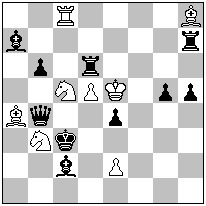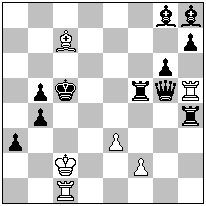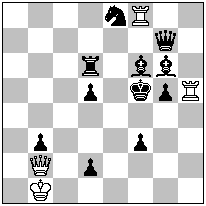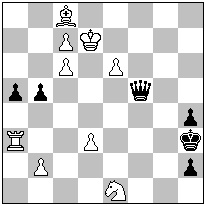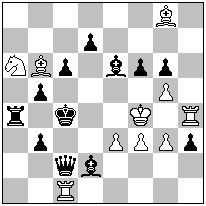by Paz Einat
מאת פז עינת
תחרות חיבור - קדם מפגש שנתי 2011 - מט עזר ב-2 מסעים
להורדת דוח התחרות בעברית
Composing Tourney - Pre Annual Meeting 2011 - helpmate in 2 moves
Theme: Required were helpmate in 2 moves that combine "Pelle movement" and royal battery. The "Pelle movement" element is a move along a pin-line. The move can be by black or by white. The royal battery can also be black or white. The black royal battery can also be used for dual avoidance. Multiple soluions, twins and duplex were allowed but not zero-position.
Judge: Paz Einat.
One of the reasons for the choice of theme was the fact that WinChloe included only 36 problems showing the required combination. The assunption that there is much room for new idea turned out to be correct. I received from the director 19 anonymous problems of a high standard, reflected by the large number of problems in the award.
The "Pelle movement" element is the more central in theme and it can be used for various effect. Of the problems containing black "Pelle movement" I preferred those showing interferences over flight square blocking. Still, a number of top problems used square blocking since they included additional interesting elements. Few problems contained white "Pelle movement" in the mating move and in those I made sure that the pin is indeed required.
|
First Prize - Jean Haymann
1.Rd3 f4 (fxe4?) 2.Rdg3 Kxe4 #
1.Rg3 fxe4 (e4?) 2.Rgd3 Kf4 #
|
Jean Haymann 1st Prize Pre-meeting T. Israel 2011
H#2 2.1.1.1 ( 8 + 11) |
|
Second Prize - Shaul Shamir & Jean
Haymann a) 1.Qxg6 Be3
2.Qc2 Kc5 # b) 1.Qxb6 Rg1 2.Qb2 Kg5 #
|
Shaul Shamir & Jean Haymann 2nd Prize Pre-meeting T. Israel 2011
H#2 b) wKb5àf5
( 9 + 9 )
|
|
Third Prize -
Menachem Witztum
a) 1.Kxe4 + Bb3 2.Qe6 Qxh7 # b) 1.Kd4 + Rf3 2.Qg7 Rxd7 #
|
Menachem Witztum 3rd Prize Pre-meeting T. Israel 2011
H#2 b) wSc2àg5 ( 8 + 14 ) |
| Forth Prize - Jean
Haymann Looks simple at a brief glance but it has movement and harmony of the kind I like (and thus its placement in the award is more subjective). These elements include the movement of king - queen compared to queen - king, the check by black once in the first move and once in the second, and battery mates once direct and once indirect. All this is done in a pleasant airy construction. 1.Kb5 + Bc3 2.Qc5 Rb2 # 1.Qe5 Bb6 + 2.Kd5+ Rc2 #
|
Jean Haymann 4th Prize Pre-meeting T. Israel 2011
H#2 2.1.1.1 ( 7 + 8 ) |
|
Fifth Prize -
Menachem Witztum & Emanuel Navon The evaluation of this problem was not simple. On the face-of-it the idea can be executed without the pin of the white queen. However, the use of the black battery, apart from preventing cooks, introduces a depth since there is a need to carefully chose between the two mate positions. In the first move black interfers with a white piece, the rook and the bishop, respectively, in each solution, to enable entry of the black king to the required square and pinning the black piece along the way. The move by the black king opens the battery and pins the queen which mates by the required "Pelle movement". a) 1.Bf3 Qb7 +
2.Kf5 Qd5 # b) 1.Rf4 Qb4 + 2.Ke3 Qd4 #
|
Menachem Witztum & Emanuel Navon 3rd Prize Pre-meeting T. Israel 2011
H#2 b) wKa8àa4 ( 10 + 10 ) |
|
1st HM - Shaul Shamir & Jean Haymann Mutual interferences by the black queen and rook: in each solution the piece moves into the pin line and then moves along it to close the line of the other piece. The movement towards and away from the black king is entertaining. The reason that this problem was not placed higher is that the royal battery is, to some extent, artificial. In the specific matrix used here one can consider another battery that enables the use of interference, as used by white's first move in the second solution by the knight. I prefer such an element over the capture of the black rook.
1.Qd4 + Kxd6
2.Qg7 Sd3 # 1.Rc7 Se6 2.Rc4 Kf5 #
|
Jean Haymann & Shaul Shamir 1st HM Pre-meeting T. Israel 2011
H#2 2.1.1.1 ( 8 + 10 ) |
| 2nd HM - Emanuel
Navon One of three problems showing interferences of two black bishops and which are under the shadow of the predecessor by Tkachenko (see at the end of the award). The main difference here is in the 2nd move by black: the rook at b8 must move to enable the mate and it must carefully chose between the two available squares. One can criticize white's first move, but I think that the interference each time by a different pieces (in the second solution the interference is clean since white has the choice of 1...Bg5) is more interesting. a) 1.Qf3 (Qe3?) Bf2 2.Rb6 (Rb5?) Kxc5 # b) 1.Qe3 (Qf3?) Rf3 2.Rb5 (Rb6?) Kxc6 #
|
Emanuel Navon 2nd HM Pre-meeting T. Israel 2011
H#2 b) wBh4àa2 ( 9 + 11 ) |
| 3rd HM - Emanuel
Navon The second problem requiring a comparison to Tkachenko. Here black is responsible for the interferences of the two bishops, but the main difference is in white's first move. White must interfere with BRh4: in the first solution d5 must be guarded and in the second d4 must be kept guarded. One can criticize the fact that 2.Qd5 both interferes with BBg8 and blocks a flight square, but in light of the dual avoidance this looks minor to me. 1.Rf7 (Re5?) e4 (f4?) 2.Qe5 Kd3 #
1.Rf6 (Rd5?) f4 (e4?) 2.Qd5 Kb1 #
|
Emanuel
Navon 3rd HM Pre-meeting T. Israel 2011
H#2 2.1.1.1 ( 6 + 11 ) |
| 4th HM -
Menachem Witztum The "Pelle Movement" in this problem is by white exploiting the pin of the black piece pinning the queen. In the first solution the pin line already exist on f file and in the second solution it is created during the solution. While in general I like such differences, here it is clear that the second solution is more interesting. a) 1.Kf4 + Ka1
2. g4 Qe5 # b) 1.Ke6 + Qc2 2.Be7 Qf5 #
|
Menachem Witztum 4th HM Pre-meeting T. Israel 2011
H#2 b) wRh5àh6 ( 4 + 11 ) |
|
5th HM - Menachem Witztum 1.Kh3 Qc8
2.Qg3 Kg8 # 1.Kh2 Ra1 2.Bg3 Kxg7 #
|
Menachem Witztum 5th HM Pre-meeting
T. Israel 2011 H#2 2.1.1.1 ( 5 + 9 ) |
| 6th HM - Menachem
Witztum An entertaining change of the white royal battery mixed with convincing interferences of the lines of the black queen the the "Pelle Movement" moves. A nice and light problem. 1.Rc5 Ke3
2.Bf6 Ke3-e4 # 1.Rf5 Ke2 + 2.Kh5 Kf1 #
|
Menachem Witztum 6th HM Pre-meeting
T. Israel 2011 H#2 2.1.1.1 ( 5 + 8 ) |
| 1st Com - Shaul
Shamir "Pelle Movements" are used here to block flight squares. The queen moves into the thematic line and then moves along it. The interferences of the black rooks, enabling their alternate capture, is the bonus in the problem. A nice and light problem. a) 1.Qg1 Sg3
2.Qb1 Kxg5 # b) 1.Qd4 Sg4 2.Qb2 Kxg2 # |
Shaul Shamir 1st Com Pre-meeting
T. Israel 2011 H#2 b) wKf6ßàwSf1 ( 6 + 7 ) |
| 2nd Com - Israel
Zur There are two solutions in each twin but the difference between the two pairs is only in the moves by the white king. Still, there is some interest in that in each solution the white king is restricted to one square. In the first solution there is a nice element: 1...Ke7? blocks the mating move by the pawn. However, this element does not appear in the other solutions. a) 1.Qxd3 + Ke8
2.Qg3 e7 # 1.Qxe6 + Kd8
2.Qg4 d4 # b) 1.Qxd3 + Ka2
2.Qg3 e7 #
1.Qxe6 + Kc2 2.Qg4 d4 # |
Israel Zur 2nd Com Pre-meeting
T. Israel 2011 H#2 b) wKd7àb3 ( 9 + 6 ) |
| 3rd Com - Israel
Han "Pelle Movement" for square blocking. In the second solution the the moves 2.Bxe3 Kxe3 are forced to guard d3 compared to the more freedom of choice in the first solution. There is of-course interest in the fact that BRa4 prevent cooks by using a thematic royal battery, but this is relatively minor. 1.Qc3 Sb4
2.fxg5 + Kxg5 # 1.Bd5 Ba5 2.Bxe3 + Kxe3 #
|
Israel Han 3rd Com Pre-meeting
T. Israel 2011 H#2 2.1.1.1 ( 10 + 12 ) |
|
4th Com - Israel Han 1.Bc5 e6 (Ke4?)
2.Qb5 Ke5 # 1.Qb5 Ke4 (e6?) 2.Bc5 Kd5 #
|
Israel Han 4th Com Pre-meeting
T. Israel 2011
H#2 2.1.1.1 ( 10 + 12 ) |
| 5th Com -
Yosi Retter The symmetry of this scheme is somewhat broken by white's first moves and by the mating moves. The critical moves should be noted. a) 1.Rb5 Bc3
2.Qc5 Kd7 # b) 1.Rd3 b4 2.Rd4 Kf6 #
|
Yosi Retter 5th Com Pre-meeting
T. Israel 2011
H#2 b) bPd3àb5 ( 6 + 9 ) |
|
Anticipations: I actually found an almost full anticipation to only one problem (unusual in a H#2 tourney), the same one mentioned in the award for the 2nd and 3rd HM's. Problem #7 (Han) differs only by that a white pawn makes the interferences of each of the bishop, and this is not enough. |
Sergy Ivanovich Tkachenko 8th HM 7th Yasinovataya 2003
H#2 2.1.1.1 ( 6 + 13 ) |





